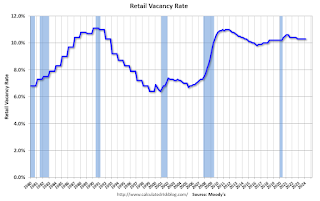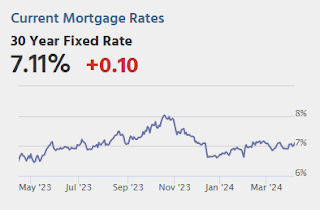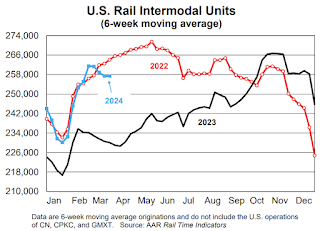by Calculated Risk on 4/09/2024 08:31:00 AM
Tuesday, April 09, 2024
Moody's: Retail Vacancy Rate Unchanged in Q1
Note: I covered apartments and offices in the newsletter: Moody's: Apartment Vacancy Rate Unchanged in Q1; Office Vacancy Rate at Record High
From Moody’s Analytics economists: Apartment and Retail in Holding Pattern, Office Evolution and Stress Continued, And Industrial Fundamentals Leveled Off
Q1 2024 data revealed trends similar to those observed in 2023, with retail vacancy rate remaining stable at 10.3%. Asking rents rose slightly by 0.2% to $21.69 per sqft, while effective rents also enjoyed 0.2% increase to $18.98 per sqft. During the holiday season, consumer activity was robust but as expected, decelerated in January as retailers reduced their expenditures at the start of the year. However, February marked a resurgence in consumer spending, with retail sales climbing by 0.6%. It is anticipated that overall retail sales in 2024 will mirror those of 2023, albeit with a larger share attributed to non-store and online transactions. The quarter also saw the addition of 198,000 square feet in new retail construction. Despite this growth, the retail sector continues to confront familiar financing obstacles due to persistent high interest rates, suggesting little change in this trend for the remainder of the year. Although bankruptcy announcements have been prevalent, the vacancy rate has remained steady. This stability is partly due to new, smaller store openings by entities that normally wouldn’t fill this space, such as Macy's and Toys R Us.
 This graph shows the strip mall vacancy rate starting in 1980 (prior to 2000 the data is annual).
This graph shows the strip mall vacancy rate starting in 1980 (prior to 2000 the data is annual). In the mid-'00s, mall investment picked up as mall builders followed the "roof tops" of the residential boom (more loose lending). This led to the vacancy rate moving higher even before the recession started. Then there was a sharp increase in the vacancy rate during the recession and financial crisis.
Monday, April 08, 2024
Tuesday: Small Business Survey
by Calculated Risk on 4/08/2024 07:08:00 PM

Mortgage rates moved up somewhat abruptly today as the bond market lost more ground over the weekend ... there weren't any compelling news headlines or economic reports driving the weakness. It would be better thought of as a hangover from Friday's jobs report.Tuesday:
As the week progresses, there will certainly be at least one major economic report with a proven track record of causing big reactions in rates: the Consumer Price Index (CPI) on Wednesday morning. With the average lender already near the highest levels since February, a bad reaction to CPI could easily launch rates back to levels not seen since November. On the other hand, if CPI manages to come in much lower than expected, rates would almost certainly drop. [30 year fixed 7.11%]
emphasis added
• At 6:00 AM ET, NFIB Small Business Optimism Index for March.
Hotels: Occupancy Rate Decreased 5.6% Year-over-year Due to Easter Holiday
by Calculated Risk on 4/08/2024 02:59:00 PM
As expected ahead of the Easter holiday, U.S. hotel performance decreased from the previous week, according to CoStar’s latest data through 30 March.The following graph shows the seasonal pattern for the hotel occupancy rate using the four-week average.
24-30 March 2024 (percentage change from comparable week in 2023):
• Occupancy: 62.3% (-5.6%)
• Average daily rate (ADR): US$157.14 (-0.7%
• Revenue per available room (RevPAR): US$97.83 (-6.3%)
emphasis added
 Click on graph for larger image.
Click on graph for larger image.The red line is for 2024, black is 2020, blue is the median, and dashed light blue is for 2023. Dashed purple is for 2018, the record year for hotel occupancy.
1st Look at Local Housing Markets in March
by Calculated Risk on 4/08/2024 01:04:00 PM
Today, in the Calculated Risk Real Estate Newsletter: 1st Look at Local Housing Markets in March
A brief excerpt:
NOTE: The tables for active listings, new listings and closed sales all include a comparison to March 2019 for each local market (some 2019 data is not available).There is much more in the article.
This is the first look at several early reporting local markets in March. I’m tracking about 40 local housing markets in the US. Some of the 40 markets are states, and some are metropolitan areas. I’ll update these tables throughout the month as additional data is released.
Closed sales in March were mostly for contracts signed in January and February when 30-year mortgage rates averaged 6.44% and 6.78%, respectively. This is down from the 7%+ mortgage rates in the August through November period (although rates are now back in the 7% range again).
...
In March, sales in these markets were down 8.9% YoY. In February, these same markets were up 2.3% year-over-year Not Seasonally Adjusted (NSA).
Sales in all of these markets are down compared to January 2019.
...
This is a year-over-year decrease NSA for these early reporting markets. However, there were two fewer working days in March 2024 compared to March 2023, so sales Seasonally Adjusted will be higher year-over-year than Not Seasonally Adjusted sales.
...
This was just a few early reporting markets. Many more local markets to come!
Leading Index for Commercial Real Estate Decreased 9% in March
by Calculated Risk on 4/08/2024 11:01:00 AM
From Dodge Data Analytics: Dodge Momentum Index Fell 9% in March
The Dodge Momentum Index (DMI), issued by Dodge Construction Network, fell 8.6% in March to 164.0 (2000=100) from the revised February reading of 179.5. Over the month, commercial planning fell 3.2% and institutional planning dropped 17.2%.
“In 2023, commercial planning decreased while institutional planning notably improved, sitting 29% above year-ago levels in February 2024. While strong market fundamentals should support institutional planning this year, this side of the Index is more at risk for a substantive correction after last year’s growth,” stated Sarah Martin, associate director of forecasting for Dodge Construction Network. “Much of the decline on the institutional side is credited to lower levels of education planning. Between February 2023 and February 2024, life science and R&D laboratory projects account for roughly 34% of education planning value, with that share reaching 59% in some months. In March, however, that share dropped to 7%. The surge of lab construction in recent years may lead to decreased planning demand as the market absorbs new supply in 2024. Likely, lower lab volumes will result in education planning returning to its long-run, and more sustainable, average.”
...
The DMI is a monthly measure of the value of nonresidential building projects going into planning, shown to lead construction spending for nonresidential buildings by a full year.
emphasis added
 Click on graph for larger image.
Click on graph for larger image.This graph shows the Dodge Momentum Index since 2002. The index was at 164.0 in March, down from 179.5 the previous month.
According to Dodge, this index leads "construction spending for nonresidential buildings by a full year". This index suggests a slowdown in 2024.
Housing April 8th Weekly Update: Inventory down 0.9% Week-over-week due to Easter Holiday, Up 24.6% Year-over-year
by Calculated Risk on 4/08/2024 08:12:00 AM
 Click on graph for larger image.
Click on graph for larger image.This inventory graph is courtesy of Altos Research.

Sunday, April 07, 2024
Sunday Night Futures
by Calculated Risk on 4/07/2024 06:11:00 PM
Weekend:
• Schedule for Week of April 7, 2024
Monday:
• No major economic releases scheduled.
From CNBC: Pre-Market Data and Bloomberg futures S&P 500 are up 14 and DOW futures are up 99 (fair value).
Oil prices were up over the last week with WTI futures at $86.91 per barrel and Brent at $91.17 per barrel. A year ago, WTI was at $80, and Brent was at $87 - so WTI oil prices are up about 8% year-over-year.
Here is a graph from Gasbuddy.com for nationwide gasoline prices. Nationally prices are at $3.58 per gallon. A year ago, prices were at $3.58 per gallon, so gasoline prices are unchanged year-over-year.
AAR: Rail Carloads Down YoY in March, Intermodal Up
by Calculated Risk on 4/07/2024 08:21:00 AM
From the Association of American Railroads (AAR) Rail Time Indicators. Graphs and excerpts reprinted with permission.
Total originated carloads on U.S. railroads fell 3.5% (31,101 carloads) in March 2024 from March 2023, their third straight monthly decline. Total carloads averaged 216,716 per week in March 2024, the fewest for any March in our records that begin in January 1988. In the first quarter of 2024, total carloads were down 4.2%, or 122,088 carloads, from the same period in 2023.
The problem is coal. ...
U.S. railroads also originated 1.02 million intermodal containers and trailers in March, up 11.7% (106,903 units) over March 2023 and their seventh consecutive year-over-year gain.
emphasis added
 Click on graph for larger image.
Click on graph for larger image.This graph from the Rail Time Indicators report shows the six-week average of U.S. Carloads in 2022, 2023 and 2024:
In March, total originated U.S. carloads fell 3.5% (31,101 carloads) from March 2023. They averaged 216,716 per week in March 2024, the fewest for any March in our records that begin in January 1988. Total carloads were down 4.2%, or 122,088 carloads, for the year to date.
 The second graph shows the six-week average (not monthly) of U.S. intermodal in 2022, 2023 and 2024: (using intermodal or shipping containers):
The second graph shows the six-week average (not monthly) of U.S. intermodal in 2022, 2023 and 2024: (using intermodal or shipping containers):U.S. railroads originated 1.02 million intermodal containers and trailers in March, up 11.7% (106,903 units) over March 2023. It’s their seventh straight year-over-year gain. ... U.S. intermodal volume in Q1 2024 was 3.27 million units, virtually the same as the average for the first quarters from 2014 to 2023 (3.28 million).
Saturday, April 06, 2024
Real Estate Newsletter Articles this Week: Office Vacancy Rate at Record High
by Calculated Risk on 4/06/2024 02:11:00 PM
At the Calculated Risk Real Estate Newsletter this week:
• Moody's: Apartment Vacancy Rate Unchanged in Q1; Office Vacancy Rate at Record High
• Freddie Mac House Price Index Increased in February; Up 5.9% Year-over-year
• ICE Mortgage Monitor: The Impact of "Golden-Handcuffs" on Mortgage Payments
• Asking Rents Mostly Unchanged Year-over-year
• Immigration and Household Formation
This is usually published 4 to 6 times a week and provides more in-depth analysis of the housing market.
Schedule for Week of April 7, 2024
by Calculated Risk on 4/06/2024 08:11:00 AM
The key economic report this week is March CPI.
No major economic releases scheduled.
6:00 AM ET: NFIB Small Business Optimism Index for March.
7:00 AM ET: The Mortgage Bankers Association (MBA) will release the results for the mortgage purchase applications index.
8:30 AM: The Consumer Price Index for March from the BLS. The consensus is for 0.4% increase in CPI (up 3.5% YoY) and a 0.3% increase in core CPI (up 3.7% YoY).
2:00 PM: FOMC Minutes, Meeting of March 19-20
8:30 AM: The initial weekly unemployment claims report will be released. The consensus is for 225 thousand initial claims, up from 221 thousand last week.
8:30 AM: The Producer Price Index for March from the BLS. The consensus is for a 0.2% increase in PPI, and a 0.3% increase in core PPI.
10:00 AM: University of Michigan's Consumer sentiment index (Preliminary for April).


